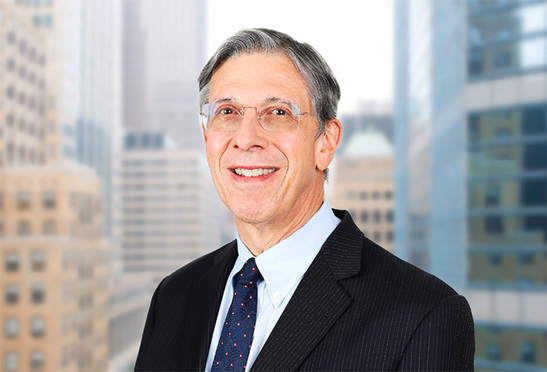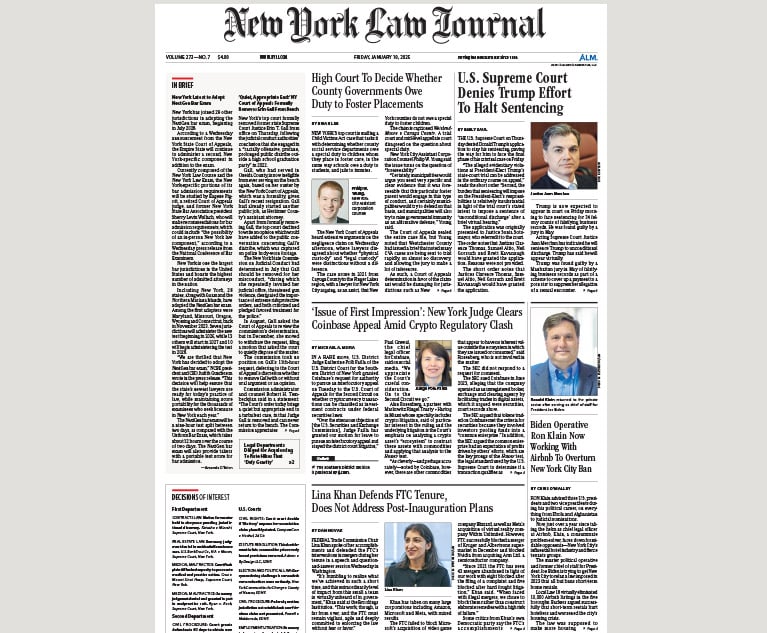The Good and the Troubling—Recent Developments in Professional Responsibility
Despite the onset of summer and the challenges facing every lawyer from the ongoing pandemic, there have been several noteworthy recent developments in the area of legal ethics.
July 03, 2020 at 11:23 AM
8 minute read
 Anthony E. Davis
Anthony E. DavisDespite the onset of summer and the challenges facing every lawyer from the ongoing pandemic, there have been several noteworthy recent developments in the area of legal ethics. This article will discuss three of them: the new, and about to be formally adopted version of New York Rules of Professional Conduct ("NY Rules") 7.5, opening up the right of New York lawyers to use tradenames; Formal Opinion 492 from the American Bar Association Standing Committee on Ethics and Professional Responsibility (Opinion 492), giving helpful instruction on the subject of obligations to prospective clients; and the rather troubling Opinion 1195 of the New York State Bar Association Committee on Professional Ethics (Opinion 1195).
Beginning with the real "news," it is a pleasure to be able to report on the announced, but not yet formally adopted change to the New York Rules which significantly reform New York's approach to a fundamental aspect of lawyer marketing. Like so much else in New York Rule 7, New York has traditionally taken a heavy-handed and restrictive approach toward what lawyers may and may not do in this realm. In the Joint Order of the Departments of the New York State Supreme Court, which is expected to be formally adopted shortly, and which very substantially rewrites and simplifies New York Rule 7.5, which currently requires that a firm name contain only the names of a current, retired or deceased partner. New York lawyers will now be permitted to use tradenames provided that they are not "false, deceptive or misleading." The new rule does contain a few other restrictions, most notably that lawyers and law firms may not include the names of nonlawyers in their firm names. In some respects, this change merely reflects the reality that firms operating in multiple jurisdictions have for a long time been using firm names in New York that effectively amount to "tradenames" without any apparent disciplinary intervention. Nevertheless, the Chief Judges of the Appellate Divisions are to be applauded for bringing the language of the New York Rules in line with the reality of the marketplace.
Opinion 492 gives important and useful guidance in understanding the application and operation of New York Rule 1.18 (which for these purposes is for all intents and purposes identical to Model Rule 1.18, to which the opinion refers). New York Rule 1.18 (a) defines a prospective client as "a person who consults with a lawyer about the possibility of forming a client-lawyer relationship with respect to a matter …" New York Rule 1.8 (b) prohibits lawyers who learn information from prospective clients from using or revealing that information except as Rule 1.9 would permit with respect to information from a former client. New York Rule 1.8 (c), to which opinion 492 is particularly addressed, prohibits lawyers who have received information as defined in (b), and their law firms, from representing "a client with interests materially adverse to those of a prospective client in the same or a substantially related matter if the lawyer received information from the prospective client that could be significantly harmful to that person in the matter, except as provided in paragraph (d)."
The importance of the opinion is that it gives guidance on the meaning of the phrase "information that could be significantly harmful." The opinion notes that the potential harm must relate to the new matter, and whether or not the information is "significantly harmful" will depend on such issues as the duration of the communication, the topics discussed, whether the lawyer reviewed documents, whether the information is known by others and the relationship between the information in the new matter.
New York Rule 1.8 (d) permits representation by such a lawyer's law firm, notwithstanding that the lawyer who received the information from the prospective client would be disqualified through having received "significantly harmful" information, subject to compliance with specific conditions by the lawyer and the law firm. In the absence of consent, the law firm may nevertheless represent another party in the same matter if the lawyer who received information from the prospective client has taken "reasonable measures to avoid exposure to more disqualifying information than was reasonably necessary to determine whether to represent the prospective client;" and the law firm gives notice to all parties including the prospective client; implements effective screening procedures to prevent the disqualified lawyer from participating in the representation of the current client; the disqualified lawyer receives no part of the fee for that matter; and a reasonable lawyer would conclude that the law firm will be able to provide competent and diligent representation.
Opinion 1195 is troubling both for what it contains and for what it fails to address. The digest on the opinion states: "A lawyer has no duty to represent clients who were clients of a former law firm and have not engaged the lawyer to represent them at a new firm, no matter whether the lawyer did work on behalf of those clients at the former firm." In order to understand the problems with the opinion, is important to refer to New York Rule 1.16 (Declining or Terminating Representation). Instead of focusing on whether and in what circumstances representation can be ended, the opinion focuses on whether or not the clients of the lawyer at the former law firm actually engage a lawyer and create a fresh client-attorney relationship at the new firm. (Notably, the opinion also correctly points out that whether or not such a relationship exists is a matter of law not of professional responsibility, and therefore is outside the scope of the opinion altogether.)
The problem is that this approach avoids the issue of lawyers' and law firms' duties to clients that arise when a lawyer changes law firms. In at least two circumstances, lawyers who leave law firms cannot thereby abandon clients whom they served at their now former firms. Nor can the old firm simply "dump" them on the departed lawyer. First, pursuant to Rule 1.16 (c) (1), lawyers may not withdraw from representation where such withdrawal "will have a material adverse effect on the interests of the client," and pursuant to Rule 1.16 (e), which requires the withdrawing lawyer to "take steps, to the extent reasonably practicable, to avoid foreseeable prejudice to the rights of the client …". Thus, if the matter is at a critical point, and the client will be harmed if he terminates the relationship, the lawyer is obligated either to continue the representation at the new firm or to make other arrangements, with the client's understanding and consent, that do not involve violating those elements of Rule 1.16. The second and related example is a situation where there is no one at the old firm who can handle it. Again, in those circumstances a lawyer cannot walk away without either continuing the representation or making appropriate arrangements for the client to be represented going forward by another lawyer. Nor can the old firm simply wash its hands of the client without making efforts to ensure that the client is not harmed. The opinion understandably does not focus on the nature of the particular client relationships at issue here, which could change the relevant responsibilities. But, put simply, in focusing on the failure to create a new relationship with the lawyer at the lawyer's new firm, the opinion fails to recognize that the relationship is not automatically terminated by the lawyer's change of firms and, for purposes of the New York Rules, does continue unless and until the provisions of Rule 1.16 are met.
Opinion 1195 is also troubling in another respect. The opinion refers to a dispute between the lawyer and his former firm with respect to the files of the clients whom the lawyer no longer wished to represent. The departing lawyer had formed his own firm, and apparently the former law firm forwarded those clients' files to the lawyer at the new firm as a means of establishing that the firm no longer represented the clients and the lawyer was obligated to do so at the new firm. This ignores the fact that the former firm is also counsel to the client and has an ongoing responsibility to ensure that the client is not harmed. This is completely contrary to the well-established case law in New York that files belong to the client and can only be transferred upon the direction of the client. Unilaterally forwarding files without such direction or consent is clearly improper until the law firm, the lawyer and the clients determine who will be responsible for the continuing representation, as discussed above, and until the client has given the appropriate instructions. The opinion regrettably fails to address this aspect of the responsibility of lawyers and law firms in transitioning clients and files.
Anthony E. Davis is of counsel at Clyde & Co US.
This content has been archived. It is available through our partners, LexisNexis® and Bloomberg Law.
To view this content, please continue to their sites.
Not a Lexis Subscriber?
Subscribe Now
Not a Bloomberg Law Subscriber?
Subscribe Now
NOT FOR REPRINT
© 2025 ALM Global, LLC, All Rights Reserved. Request academic re-use from www.copyright.com. All other uses, submit a request to asset-and-logo-licensing@alm.com. For more information visit Asset & Logo Licensing.
You Might Like
View All

Sullivan & Cromwell Signals 5-Day RTO Expectation as Law Firms Remain Split on Optimal Attendance
Law Firms Mentioned
Trending Stories
- 1'It's Not Going to Be Pretty': PayPal, Capital One Face Novel Class Actions Over 'Poaching' Commissions Owed Influencers
- 211th Circuit Rejects Trump's Emergency Request as DOJ Prepares to Release Special Counsel's Final Report
- 3Supreme Court Takes Up Challenge to ACA Task Force
- 4'Tragedy of Unspeakable Proportions:' Could Edison, DWP, Face Lawsuits Over LA Wildfires?
- 5Meta Pulls Plug on DEI Programs
Who Got The Work
Michael G. Bongiorno, Andrew Scott Dulberg and Elizabeth E. Driscoll from Wilmer Cutler Pickering Hale and Dorr have stepped in to represent Symbotic Inc., an A.I.-enabled technology platform that focuses on increasing supply chain efficiency, and other defendants in a pending shareholder derivative lawsuit. The case, filed Oct. 2 in Massachusetts District Court by the Brown Law Firm on behalf of Stephen Austen, accuses certain officers and directors of misleading investors in regard to Symbotic's potential for margin growth by failing to disclose that the company was not equipped to timely deploy its systems or manage expenses through project delays. The case, assigned to U.S. District Judge Nathaniel M. Gorton, is 1:24-cv-12522, Austen v. Cohen et al.
Who Got The Work
Edmund Polubinski and Marie Killmond of Davis Polk & Wardwell have entered appearances for data platform software development company MongoDB and other defendants in a pending shareholder derivative lawsuit. The action, filed Oct. 7 in New York Southern District Court by the Brown Law Firm, accuses the company's directors and/or officers of falsely expressing confidence in the company’s restructuring of its sales incentive plan and downplaying the severity of decreases in its upfront commitments. The case is 1:24-cv-07594, Roy v. Ittycheria et al.
Who Got The Work
Amy O. Bruchs and Kurt F. Ellison of Michael Best & Friedrich have entered appearances for Epic Systems Corp. in a pending employment discrimination lawsuit. The suit was filed Sept. 7 in Wisconsin Western District Court by Levine Eisberner LLC and Siri & Glimstad on behalf of a project manager who claims that he was wrongfully terminated after applying for a religious exemption to the defendant's COVID-19 vaccine mandate. The case, assigned to U.S. Magistrate Judge Anita Marie Boor, is 3:24-cv-00630, Secker, Nathan v. Epic Systems Corporation.
Who Got The Work
David X. Sullivan, Thomas J. Finn and Gregory A. Hall from McCarter & English have entered appearances for Sunrun Installation Services in a pending civil rights lawsuit. The complaint was filed Sept. 4 in Connecticut District Court by attorney Robert M. Berke on behalf of former employee George Edward Steins, who was arrested and charged with employing an unregistered home improvement salesperson. The complaint alleges that had Sunrun informed the Connecticut Department of Consumer Protection that the plaintiff's employment had ended in 2017 and that he no longer held Sunrun's home improvement contractor license, he would not have been hit with charges, which were dismissed in May 2024. The case, assigned to U.S. District Judge Jeffrey A. Meyer, is 3:24-cv-01423, Steins v. Sunrun, Inc. et al.
Who Got The Work
Greenberg Traurig shareholder Joshua L. Raskin has entered an appearance for boohoo.com UK Ltd. in a pending patent infringement lawsuit. The suit, filed Sept. 3 in Texas Eastern District Court by Rozier Hardt McDonough on behalf of Alto Dynamics, asserts five patents related to an online shopping platform. The case, assigned to U.S. District Judge Rodney Gilstrap, is 2:24-cv-00719, Alto Dynamics, LLC v. boohoo.com UK Limited.
Featured Firms
Law Offices of Gary Martin Hays & Associates, P.C.
(470) 294-1674
Law Offices of Mark E. Salomone
(857) 444-6468
Smith & Hassler
(713) 739-1250








